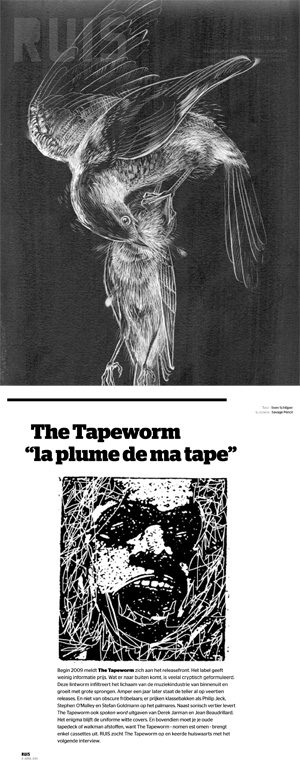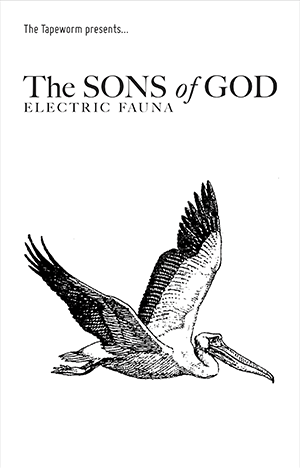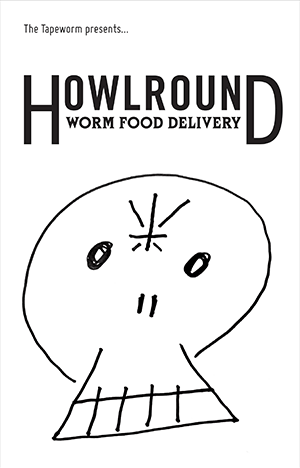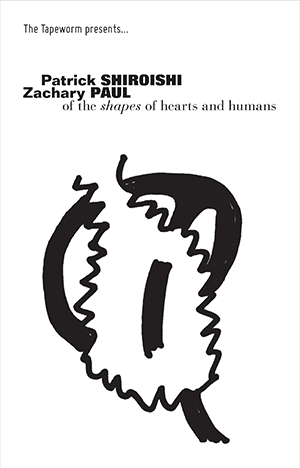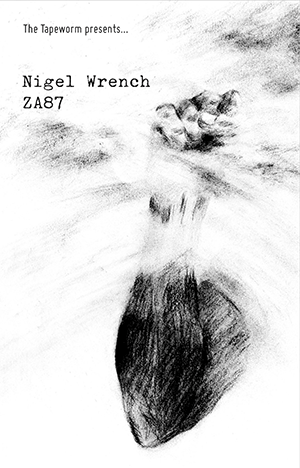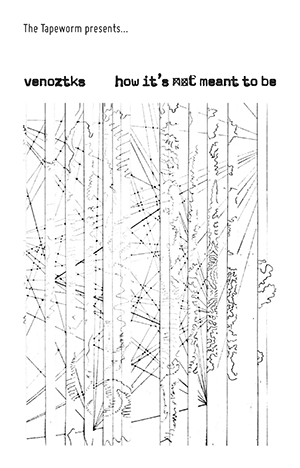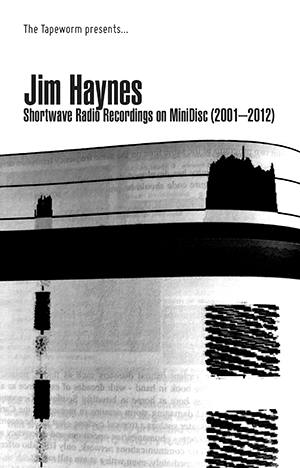"La Plume de ma Tape" - RUIS Magazine interview, 04.2010
This interview was conducted by Sven Schlijper and originally published in RUIS Magazine issue #58 (April 2010). Visit www.kraak.net to download the magazine as a .pdf and read the interview in its original Dutch.
When starting a new label, why did The Tapeworm decide to opt for the cassette as the “weapon of choice”?
We did not choose the tape. Tape chose us. Please allow me to explain. One Worm had been gifted a limited edition tape by Joachim Nordwall of iDEAL Recordings. It was a fine thing. At the same time, another of the Worms had been commissioned to create a sound installation for a small but perfect Kreuzberg gallery, based on an N-th generation videotape - wow-and-flutter a-gogo - hey, this would sound great as a tape! Worm three knew what we should be called and a logo appeared out of nowhere, fast. A sweet idea, shared by friends - seemingly simple as that. Then we dreamed on...
Of course as many of our certain age might The Tapeworm has a respect for the format. The Tapeworm recalls being frightfully excited at a young age to learn that the Art of Noise's singles were, when experienced in the superior cassette format, radically remixed - fantastic Horn and Morley maulings of the original 12”s. The Tapeworm can remember standing by the Wall, or where the Wall once was, exiting E-Werk or Tresor, blinking in barren Berlin daylight in its 1990s. The Tapeworm has shoeboxes full of mixtapes, cherished memories from back then. And that is not to even go deeper, to the underground tape cultures that thrived and thrive to this day, or amazing 80s publications such as Audio Arts' editions. Or back to basics - John Peel and the Top 40, tape trading in the playground.
However this is not a project by misty-eyed retro-fetishists attempting to snog a dead format back to life. What we do is, contrary to the convenient edited thoughts of certain quarters, not intended to be about retro-chic, boutique label cool. Something totally other, in fact.
We gave consideration to what we love about the format: its shape, its feel, its difficulties, its packaging, its limitations. This is what excited us about the project. What The Tapeworm is, is a question posed to artists and consumers, asking all parties involved in the process to embrace a set of sexy restrictions.
Who's part of the Tapeworm crew?
Technically, there are millions of us ...
What are the ties between The Tapeworm and Touch?
Touch have been a great support helping us find our feet, which is a darned hard thing for a worm to do, you know. Mike Harding assists with our logistics, selling our tapes in the TouchShop, helping with distribution, getting our editions to Forced Exposure Stateside and suchlike. But, editorially we are a totally separate entity with entirely different aims.
With the A and B side(s) on cassette tapes playing a key role in some of the editions, do you think the A and B perspective in music and (sound)art or live in general is often too easily glanced over or not internalised or given deeper thought; i.e. the idea of different perspectives or irony?
Every technology has its own limitations. Out of limitations grow strengths, ways of working around a problem. The compact disc had its duration defined and proposed dimensions redefined when Sony decided it should be able to fit all of Beethoven's 9th on it, uninterrupted: a technological convention defined by an arbitrary decision. Many similar stories can be discovered in vinyl's history (RCA Victor's name tells a tale). With CD, the art of sequencing music into A and B sides started to become less cared for; careless. Now, as we dive deeper into an iPop era, even the concept of a suite of music in a certain specified order seems somewhat old hat. So, obviously, when considering the tape format, artists can take the opportunity to rewind and rethink. Their music will be presented as A/B and its audience shall not have the easy convenience of skipping or shuttling through. When we decided to edition on the tape format, we wanted its differences to be amplified, made into strengths. Many of our contributors have taken the A and the B to heart when submitting work to us. Some have gone one better, such as Stefan Goldmann, whose tape for us is programmed in such a way that the suite of music on the A-side is different to that on its B, but beat-matched, so one can create new listening experiences by hitting the Autoreverse button. Such a splendid idea. Another great feature of the cassette is it considerably more flexible in duration than wax (consider the tape's enduring popularity in the long-form audiobook market), while retaining the A/B split of vinyl.
We are charging into an era where, seemingly, all music is fantastically available, all the time, a click away, oftentimes even before it's released... How wonderful! Yet, this abundance, this glut, is seemingly altering how we digest music - no longer collecting, instead collating a virtual archive. It strikes us that the download experience trades convenience for engagement - easy-come, easy-go. The Tapeworm makes life awkward! Here's a compendium of fantastic music from a broad range of cult contributors. Their work for us is available in minute editions from a few locations in a supposedly dead format. These tracks will, mostly, not be found anywhere else, nor reissued. The format enforces the audience to listen to the artists works in a sequence. Play, turn over. The format's supposed awkwardness will, we hope, focus the listener, force the listener into making the required effort, to commit.
Of course, it should be noted that our lives are made considerably easier thanks to “the cloud” - FTP, email and suchlike make this project possible. In no way are we luddites clinging to a faded past. We are simply interested in seeing how an artist and their audience respond to a challenge, a set of restrictions ...
Cassettes keep a warm place in many people's memory from the complition tapes made for friends and lovers in forlorn days. The Tapeworm concentrates on bringing high art to the format. does this imply a premeditated merge of high and low (popular) arts by means of the format as representational for an ongoing blurring of barriers of high and low? Is there still any high/low distinction? Is The Tapeworm per se high art and decidedly “elitist”, for example in the limited amounts of tapes released? Or can there be no elitist stance since there's no high nor low, thus no elite to speak of?
High or low does not interest The Tapeworm. Good or bad does.
We keep our editions low for the obvious reasons. We want to create a series of collectables, yes. We also want to keep their turn-around fast - partially as this excites us personally, partially as this creates its own momentum... But the most fundamental reason to edition in low numbers is, that is simply how many we can comfortably sell!
The tape has historically brought us high-art content - think back to Audio Arts editions of the earliest Touch tape magazines from the 80s, for example. However, The Tapeworm has no specific desire to be seen as high-art. That seems somewhat of a tired concept. All we ultimately care about is, releasing the best possible product created by our friends, colleagues and people we deeply admire. All that matters is that each edition is strong. The Tapeworm's dream? An edition by Pet Shop Boys - is that “high-art”? Would the context make it into art ?
A dear friend of The Tapeworm, Kamal Ackarie, put out a splendid release a few years ago. Titled “Recovery” it was a Box Set of twenty cover versions - ten 7" singles, lovingly packaged, performed by some of the brightest stars from the avant-garde. Fennesz covering a-Ha, Robert Lippok performing a Wham! song, Ryoji Ikeda deconstructing ACDC... This release revealed the surprising and seemingly incongruous relationships that often exist between these artists' earliest musical inspirations and their own unique current practices. These barriers do not need to be blurred from an artists' viewpoint, seemingly.
Does the name The Tapeworm imply an objective to infiltrate the body of the current music industry and eat at it from the inside? plus: in the process of doing so prolifically growing itself and thus taking over from the inside? Still: The Tapeworm retains a non-parasitic course of action, therefore: could this be a very specific and hithereto unknown species of “taenia”…?
Great idea! I wish we had thought of it ...
From spoken word to noise to modern classical and drones The Tapeworm features a quite diverse range of sounds. where will the roster expand to next?
Who knows! The Tapeworm's collective tastes are very broad-ranging, from black metal to Berlin techno. We have a hit-list - artists we lust over whom we would dearly love to contribute. And then, there's always the unknown... Currently, there are six tapes in various stages of completion, with invites extended wide to others we wish to ensnare! We are interested in releasing fantastic works created for a fantastic format by fantastic artists - so, let's see what happens next!
And: can you forsee The Tapeworm ever crossing over to other release formats or does the Tapeworm crew envision releases on other 'near-dead' (this is to quote the mainstream idea) formats?
The Tapeworm's members (and, remember, there are millions of us) already work on a daily basis with other media, plastic and physical, print and digital. But, The Tapeworm is its own world. Let me think - ah yes! Books, perhaps? The Bookworm - gosh!
And to tie-in with this: what comes first, the fetish for a certain format or the music as such? For example: Aphex Twin once made a commissioned piece of sound art using the unique shuffle feature of the MiniDisc format allowing short snippets of music to be randomly played, forming a unique pattern every playback. Therein the format was the primary force for the development of the music contained on the MiniDisc.
I am certainly aware of the Gescom MiniDisc-only release. I believe Stefan Goldmann calls what we do format fetish. We are certainly fetishising the format, no doubt - but, hopefully my answers above give lie to the fact that we are interested in an artist's reaction to a format and the audience's response...
Can you inform us on any of the forthcoming editions of The Tapeworm?
Leslie Winer has an amazing tape for us, titled “& That Dead Horse”. Leslie is a splendid mystery. She found fame in 80s New York as one of the first Supermodels. An enfant terrible, she soon split, befriending Basquiat then becoming Burrough's assistant. In the early 90s she recorded her sole album, under the artist name © - “Witch” was a phenomenally prescient album, predicting many of the stoned tones of the mid-90s. Then, silence. This is her first release since then.
John Butcher needs no introduction. He is contributing a pair of recordings. One side live from L'eglise Saint Merri, Paris, last November coupled with a recording for saxophone controlled feedback and piano (no overdubs, played together). Quite simply spectacular.
The Tapeworm loves pop with an edge. Edgy popster Zerocrop is contributing something splendid. The release will be titled “On Tape”. Its lead track, Dear Jim, is a beautiful electro-ballad, its chorus dubbed directly from an ansafone tape message a former lover left for him, years ago. Very unexpected and special.
Edition Mego's very own Peter Rehberg has a mesmeric tape due, maybe May... Seemingly the same song on both sides - or is it...?
And finally, Fennesz...


